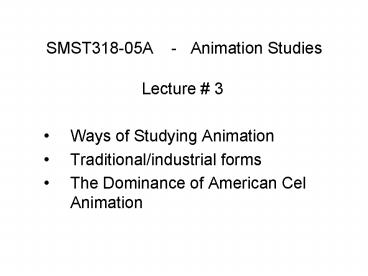SMST31805A Animation Studies - PowerPoint PPT Presentation
1 / 16
Title:
SMST31805A Animation Studies
Description:
Disney's first sound-on-film, Steamboat Willie (1928) ... Disney's Realism - Plausible Impossibility' 'The first duty of cartoons is not to picture or ... – PowerPoint PPT presentation
Number of Views:39
Avg rating:3.0/5.0
Title: SMST31805A Animation Studies
1
SMST318-05A - Animation Studies
- Lecture 3
- Ways of Studying Animation
- Traditional/industrial forms
- The Dominance of American Cel Animation
2
Defining Animation
by Technique
- The technique of single frame cinematography(Sm
all Levinson, 1989) - Two factors link these diverse media and their
variations, and serve as the basis for a workable
definition of animation - The imagery is recorded frame by frame
- the illusion of motion is created, rather than
recorded (Charles Solomon, 1988)
3
Defining animationby form
The artificial creation of the illusion of
movement in inanimate lines and forms (Wells,
1998 10)
4
Defining Animation by Function
Animation is not the art of drawings that move
but the art of movements that are drawn What
happens between each frame is much more important
than what exists on each frame. Animation is
therefore the art of manipulating the invisible
interstices that lie between the frames.
(Norman McLaren, 1957).
5
To animate is to give life and soul to a
design, not through the copying but through
the transformation of reality (Philosophy of
the Zagreb School, in Holloway, 1972 9)
6
If it is the life-action films job to present
physical reality, animated film is concerned
with metaphysical reality - not how things
look, but what they mean (Hoffer, 1981 3)
7
Historical Context
- Common perception that animation is
- American
- Created with cel artwork
- Made by famous men
- 4. Produced by Disney studio
8
- Early Development of Cel Animation
- From 1910
- Retracing
- The Slash System (Barre)
- The perf peg alignment system (Barre)
- From 1914
- Clear, flexible cels (Hurd Bray)
9
- Taylorism advocates the use of machines
- and standardized, mechanized processes to
- assure uniform and predictable output.
- Division of labor is key
- Laborers work can be regulated
- systematically.
- The notion of individual craftsmanship
- goes against the principles of Taylorism.
10
Influence of Taylorism
- The eventual domination of cel animation in
western societies can be attributed to the
compatibility of techniques with the capitalist
industrial system. - The distribution of labour that can be achieved
with drawn animation allows key creative
individuals to do initial design work, while less
skilled and lower paid workers complete the most
repetitive tasks.
11
Why was Disney so successful?
12
- Formula
- remaking successful films using similar plots
- duplication of similar character types
- Applying the classical narrative structure
- Drawing on the success of other genres
- and art forms
13
- Novelty
- product differentiation
- innovations in animation technology
- - Sound
- - Colour
- - Dimension
- - Format
14
Out of the possibilities of sound
synchronization a world of sound must be
created, as refined in abstraction as the old
silent artIt is no accident that of all the
comedy workers of the new regime, the most
attractive by far, is the cartoonist,
Disney Making his sound strip first and working
his animated figures in distortion and
counterpoint to the beat of the sound, he has
begun to discover those ingenious combinations
which will carry on the true tradition of film
comedy (Grierson, 1935).
15
- Chronology of Technical Innovations (1920s
-1940s) - Fleischers use of rotoscoping in Out of the
Inkwel, (1919) - Disneys live action/animation series, Alice
Comedies (1923) - Fleischers Song Car Tunes (1924)
- Disneys first sound-on-film, Steamboat Willie
(1928) - Fleischers first use of sound-on-film
processes with the - Phonofilm system (1924-1925) and Noahs Ark
(1929) - Disneys 3 year exclusive contract with
Technicolor (1932) - Fleischers use of other colour systems
introduction of the - Stereoptical process (1934)
- Fleischers move to longer special formats
(1936) - Disneys use of the multiplane camera in The
Old Mill (1937) - Disneys feature length film, Snow White (1937)
- Fleischers feature-length film, Gullivers
Travels (1939).
16
Disneys Realism - Plausible Impossibility The
first duty of cartoons is not to picture or
duplicate real action or things as they actually
happen but to give a caricature of both life
and actionI definitely feel that we cannot do
the fantastic things, based on the real, unless
we first know the real (Disney in Canemaker,
1979).































